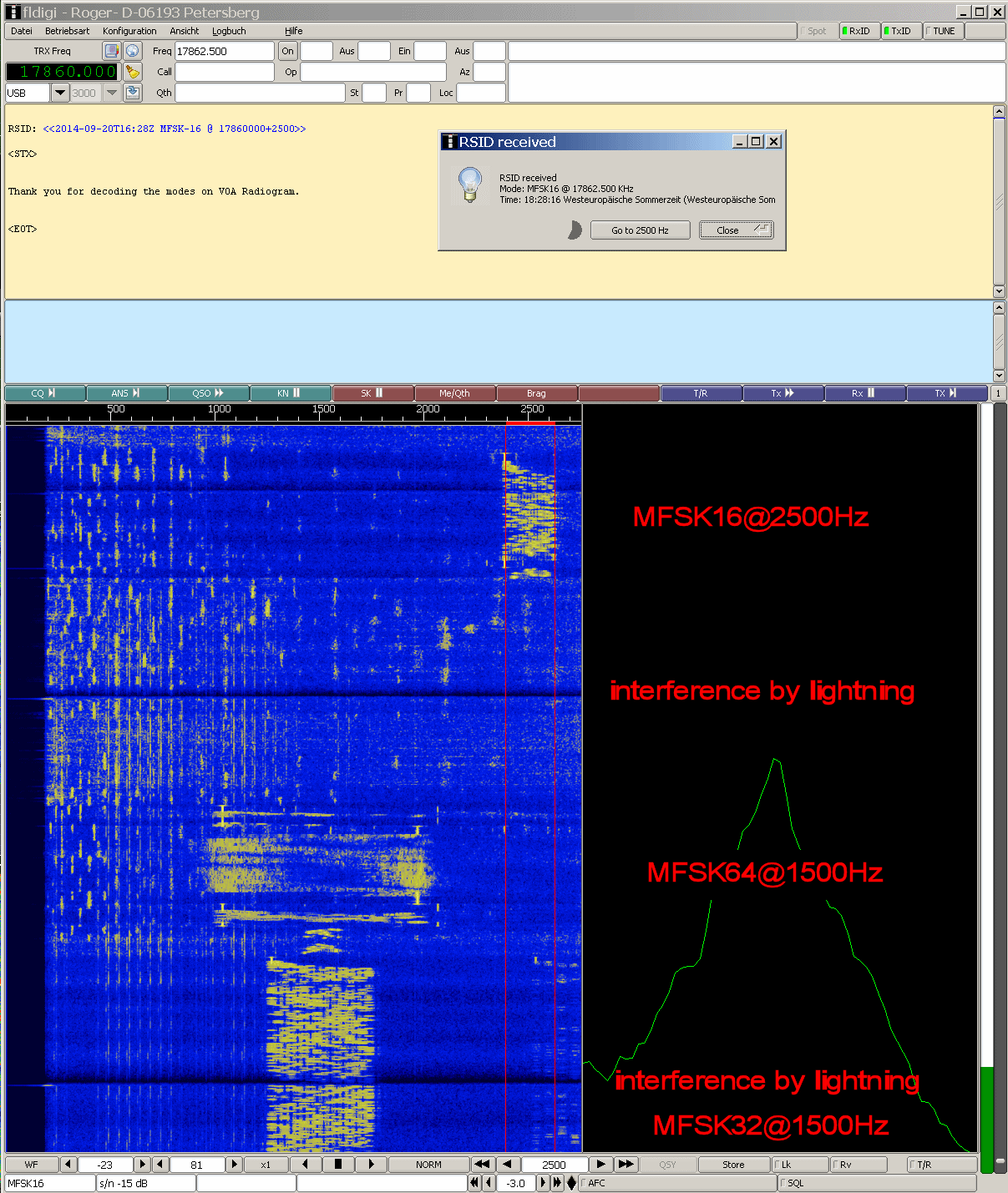
|
www.rhci-online.net/radiogram/radiogram.htm
██╗ ██╗██████╗ ██████╗ ██████╗ █████╗ ██████╗ ██╗ ██████╗ ██████╗ ██████╗ █████╗ ███╗ ███╗ ██║ ██╔╝██╔══██╗██╔════╝ ██╔══██╗██╔══██╗██╔══██╗██║██╔═══██╗██╔════╝ ██╔══██╗██╔══██╗████╗ ████║ █████╔╝ ██████╔╝██║ ██████╔╝███████║██║ ██║██║██║ ██║██║ ███╗██████╔╝███████║██╔████╔██║ ██╔═██╗ ██╔══██╗██║ ██╔══██╗██╔══██║██║ ██║██║██║ ██║██║ ██║██╔══██╗██╔══██║██║╚██╔╝██║ ██║ ██╗██████╔╝╚██████╗ ██║ ██║██║ ██║██████╔╝██║╚██████╔╝╚██████╔╝██║ ██║██║ ██║██║ ╚═╝ ██║ ╚═╝ ╚═╝╚═════╝ ╚═════╝ ╚═╝ ╚═╝╚═╝ ╚═╝╚═════╝ ╚═╝ ╚═════╝ ╚═════╝ ╚═╝ ╚═╝╚═╝ ╚═╝╚═╝ ╚═╝
|
RSID:
<<2014-09-20T11:30Z MFSK-64
@ 6095000+1500>>
<STX>
Sending Pic:179x102C;

<EOT>
|
During
the VoA
datacast
on
17860 kHz/16.00z
there were
again strong
interferences
by local lightning strikes.
roger |
██╗ ██╗ ██████╗ █████╗ ██████╗ █████╗ ██████╗ ██╗ ██████╗ ██████╗ ██████╗ █████╗ ███╗ ███╗ ██║ ██║██╔═══██╗██╔══██╗ ██╔══██╗██╔══██╗██╔══██╗██║██╔═══██╗██╔════╝ ██╔══██╗██╔══██╗████╗ ████║ ██║ ██║██║ ██║███████║ ██████╔╝███████║██║ ██║██║██║ ██║██║ ███╗██████╔╝███████║██╔████╔██║ ╚██╗ ██╔╝██║ ██║██╔══██║ ██╔══██╗██╔══██║██║ ██║██║██║ ██║██║ ██║██╔══██╗██╔══██║██║╚██╔╝██║ ╚████╔╝ ╚██████╔╝██║ ██║ ██║ ██║██║ ██║██████╔╝██║╚██████╔╝╚██████╔╝██║ ██║██║ ██║██║ ╚═╝ ██║ ╚═══╝ ╚═════╝ ╚═╝ ╚═╝ ╚═╝ ╚═╝╚═╝ ╚═╝╚═════╝ ╚═╝ ╚═════╝ ╚═════╝ ╚═╝ ╚═╝╚═╝ ╚═╝╚═╝ ╚═╝
RSID: <<2014-09-20T16:01Z
MFSK-32 @ 17860000+1500>>
<STX>
Welcome to program 77 of VOA Radiogram from the Voice of America.
I'm Kim Andrew Elliott in Washington.
Here is the lineup for today's program (MFSK32):
1:34 Program preview (now)
2:35 Device produces water from fog, with image.
7:34 NASA contract for manned spacecraft, with
image
11:33 NASA's asteroid detection effort, with image
18:15 US information "battle" with Russia, IS
26:41 Closing announcements
Please send reception reports to radiogram@voanews.com.
And visit voaradiogram.net
Twitter: @VOARadiogram
<EOT>
<STX>
VOA NEWS
Nature-Inspired Design Collects Water from Fog
Faith Lapidus
September 17, 2014
A simple device, inspired by the beaks of shorebirds, can harvest
drops of water from fog and dew. Its developers say it could help
drought-prone communities around the world meet their need for
drinkable water.
University of Texas at Arlington engineering professor Cheng Luo
and his doctoral student Xin Heng came up with their design after
noting how long-billed shorebirds with thin beaks get water.
Birds like sandpipers and stilts push liquid back into their
throats by opening and closing their beaks. So the researchers
hinged two rectangular glass plates together. When the collector
is open, it provides a large surface area where beads of fog can
condense. As it closes, the water drops slide into a collection
tube near the hinge.
Writing in the American Chemical Society journal ACS Applied
Materials & Interfaces, Luo reports that a single 25-by-10
centimeter prototype harvested about 15 milliliters of water in a
half hour.
Over a two-hour span, it gathered 400 to 900 times more liquid
than any other natural or artificial fog-collector.
http://www.voanews.com/content/nature-bio-inspired-fog-collector-water/2453094.html
See also:
http://www.uta.edu/news/releases/2014/09/birdbeak-water-luo.php
<EOT>
<STX>
Image: Fog could become a valuable water source in
drought-stricken areas like California...
<EOT>
<STX>
Sending Pic:256x171C;
|
|
|
<EOT>
<STX>
This is VOA Radiogram from the Voice of America.
Please send reception reports to radiogram@voanews.com.
NASA Picks Contractors to Resume Manned Space Flight
VOA News
September 16, 2014
The United States has taken a major step towards once again
launching astronauts into orbit from U.S. soil.
The U.S. space agency NASA named two private companies — Boeing
and Space Exploration Technologies Corporation — to build and
launch spacecrafts to and from the International Space Station.
NASA has relied on Russia to transport crews since it retired its
space station fleet in 2011.
It hopes to resume launches from the U.S. in 2017.
NASA chief Charlie Bolden said Tuesday that the Obama
administration has made it clear that what he calls the "greatest
nation on Earth" should not have to depend on others to fly
astronauts into space.
Bolden also says turning over low-orbit space missions to private
companies would allow NASA to focus on the next major project — a
manned mission to Mars.
http://www.voanews.com/content/nasa-contractors-manned-space-flight/2452171.html
<EOT>
<STX>
Image: Boeing's Crew Space Transportation (CST)-100...
<EOT>
<STX>
Sending Pic:200x160C;
|
|
denoised |
|
|
|
<EOT>
RSID: <<2014-09-20T16:10Z
MFSK-32 @ 17860000+1500>>
<STX>
This is VOA Radiogram from the Voice of America.
Please send reception reports to radiogram@voanews.com.
Report: NASA Failing in Mission to Find Dangerous Asteroids Near
Earth
VOA News
September 15, 2014
The U.S. space agency's inspector general says NASA is failing in
its congressionally-ordered mission to find 90 percent of
potentially dangerous asteroids flying close to Earth.
The official, Paul Martin, Monday criticized the agency's Near
Earth Object program as being understaffed and badly managed.
In his report, he says the program has so far found just 10
percent of asteroids and other objects bigger than 140 meters
across and flying 45 million kilometers from Earth.
The program is tasked with finding 90 percent of these objects.
The inspector general's report says the program likely will miss
its 2020 deadline.
Most near-Earth objects harmlessly disintegrate before striking
the planet.
But a relatively small asteroid exploded over Chelyabinsk in
southern Russia last year with the force of 30 atomic bombs. More
than 1,000 people were injured by flying debris.
"Recent research suggests that Chelyabinsk-type events occur
every 30 to 40 years," the Office of Inspector General report
said, adding that most impacts would occur in the ocean rather
than in populated areas.
Historians believe a 10-kilometer-wide object hit the Earth about
66 million years ago in what is now Mexico, killing nearly all
life on the planet and causing dinosaurs to become extinct.
Since 1998, NASA has spent about $100 million on programs to
find, assess and mitigate potentially threatening space
neighbors.
The report made five recommendations for beefing up NASA's
asteroid detection efforts, including adding at least four to
six employees to help manage the program and coordinating
projects with other U.S. and international agencies and with
privately-funded initiatives.
NASA's Associate Administrator for Science John Grunsfeld said in
a letter to Martin he expects a new NEO program to be in place by
Sept. 1, 2015.
Some information for this report provided by Reuters.
http://www.voanews.com/content/nasa-failing-mission-to-find-dangerous-asteroids/2451039.html
<EOT>
Image: Image courtesy of NASA shows an artist's concept of a
broken-up asteroid. Scientists think that a giant asteroid, which
broke up long ago in the main asteroid belt between Mars and
Jupiter, eventually made its way to Earth and led to the
extinction of the dinosaurs...
<EOT>
<STX>
Sending Pic:299x171C;
|
|
denoised |
|
|
|
<EOT>
RSID: <<2014-09-20T16:17Z
MFSK-32 @ 17860000+1500>>
<STX>
This is VOA Radiogram from the Voice of America.
Please send reception reports to radiogram@voanews.com.
VOA NEWS
Under Secretary Stengel: US in Information 'Battle' with IS,
Russia
Alex Villarreal
September 16, 2014
U.S. Under Secretary of State for Public Diplomacy and Public
Affairs Richard Stengel says that in the face of strong foreign
propaganda machines such as Russia and the Islamic State, the
U.S. needs to harden its "soft power" with its own participation
in the global conversation.
Speaking in Washington Tuesday at an event hosted by the
non-partisan American Security Project, Stengel called engagement
"a sign of strength," and said the United States should be the
nation that listens.
He said recent changes in technology, including the rise of
social media, are suitable to making public diplomacy more
important in the 21st century than ever before, as the world is
seeing "a reemergence of history, a reemergence of blood and
borders" from Ukraine to the Middle East to Southeast Asia.
The U.S. Advisory Commission on Public Diplomacy also met Tuesday
in Washington to discuss the impact of international broadcasting
and recommendations for engaging foreign audiences.
'Competition' with Russia
On Russia and the global conversation about the Ukraine conflict,
Stengel said when he took up his post at the State Department in
February, he was "surprised and displeased" by how powerful the
Russian propaganda machine was - not just in Russia, but in the
surrounding region of Russian speakers.
He said competing with Russian news, which he described as
"nothing like what we think of as objective," is something the
U.S. is now focusing on, including through the Voice of America.
VOA Director David Ensor was present for Stengel's remarks.
Stengel, who came to State after seven years as the managing
editor of TIME magazine, said the U.S. is focused now on getting
its point of view out in the Russian language, but not through
broadcasting, which he called "an old model." Instead, he said
the U.S. is turning to social media.
The Russian leadership has been criticized recently for a wave of
Internet restrictions that appear designed to stifle dissent
online. The closing off of the Internet information space has
"grave implications" for public diplomacy, said Stengel, and it
is a trend against which he said he is trying to campaign.
The Kremlin denies allegations of censorship or pressure on the
media, but online activists and journalists have been
increasingly concerned that President Vladimir Putin is seeking
to tighten control over Russian society, amid the bitter dispute
between Russia and the West over Ukraine's future.
'Information Battlefield'
Stengel also addressed the rise of the Islamic State militant
group, which has overtaken large amounts of territory in both
Iraq and Syria, saying that apart from its "savage" beheadings of
American journalists and other violence, the group has proven
"very adept" at information warfare.
Staffan Truve, an analyst with the social media monitoring group
Recorded Future, told VOA recently that more than 60,000 Twitter
accounts this summer were talking about Islamic State extremists
in a positive way.
Patrick Skinner with the Soufan Group, a security intelligence
services company, says the Islamic State's international
recruitment drive is equally skillful. He says the group's
message is carefully tailored to specific demographic groups in
Europe, the United States and South Asia, as well as locally in
Iraq and Syria.
Stengel, fresh from a trip to the Middle East with Secretary of
State John Kerry, said the U.S. is in a battle with the Islamic
State that is not just being fought on a "kinetic battlefield,"
but on an "information battlefield" as well. But he said the
group's ability to recruit foreign fighters has more to do with
conditions the U.S. does not control, such as region specific
economic and social problems.
Broadcasting Reform?
Some media advocacy groups have expressed concerns about the U.S.
government waging "information warfare" through its international
broadcasting institutions such as VOA, Radio Free Europe and
Radio Free Asia. Reporters Without Borders Secretary-General
Christophe Deloire issued a statement in May saying that would be
extremely regrettable.
Deloire's statement came in response to a bill the House of
Representatives passed in July that would overhaul U.S.
international broadcasting to support U.S. foreign policy.
The bill would reduce the scope of VOA's coverage from world news
to coverage of the United States and international developments
that affect the U.S. - a change some current and former VOA
journalists say would be "devastating" to VOA's credibility and
integrity.
But supporters of the bill say it would help the U.S. fight back
more effectively in the war of information against countries like
Russia and China. Democrat Eliot Engel, co-sponsor of the House
bill, says the legislation will require U.S. broadcasting
agencies to remain "objective sources of news and information,"
not just "a mouthpiece for U.S. foreign policy."
A similar U.S. broadcasting bill must pass in the Senate, and the
legislation must be signed by President Barack Obama in order to
become law.
http://www.voanews.com/content/under-secretarty-stengel-us-in-information-battle-with-is-russia/2452158.html
<EOT>
RSID: <<2014-09-20T16:26Z
MFSK-32 @ 17860000+1500>>
Please send reception reports to radiogram@voanews.com.
And visit voaradiogram.net.
Twitter: @VOARadiogram
Thanks to colleagues at the Edward R. Murrow shortwave
transmitting station in North Carolina.
I'm Kim Elliott. Please join us for the next VOA Radiogram
This is VOA, the Voice of America.
<EOT>
RSID: <<2014-09-20T16:26Z MFSK-64
@ 17860000+1500>>
<STX>
Sending Pic:209x19C;
|
|
denoised |
|
|
|
<EOT>
RSID: <<2014-09-20T16:28Z
MFSK-16
@ 17860000+2500>>
<STX>
Thank you for decoding the modes on VOA Radiogram.
<EOT>

www.rhci-online.net/radiogram/radiogram.htm
|
QTH: |
D-06193 Petersberg (Germany/Germania) |
|
Ant.: |
Dipol for 40m-Band |
|
RX: |
FRG-100 + IF-mixer |
|
Software IF: |
con STUDIO1 - Software italiano per SDR [SAM-USB] |
|
Software AF: |
|
|
OS: |
German XP-SP3 with support for asian languages |
|
PC: |
MEDION Titanium 8008 (since 2003) [ P4 - 2,6 GHz] |